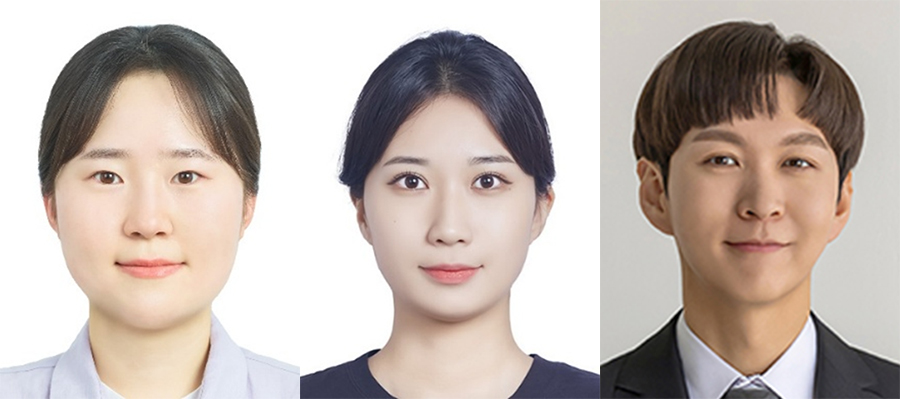커뮤니티
부경투데이
- 국립 부경대학교의 다양한 모습과 소식을 접하시면 부경대학교가 한번 더 가까워집니다.
| 첨단 항노화 소재 원리 찾았다(New Mechanism Behind Advanced Anti-Aging Material Discovered) | |||
| 작성자 | 대외홍보센터 | 작성일 | 2025-06-11 |
| 조회수 | 705 | ||
| 첨단 항노화 소재 원리 찾았다(New Mechanism Behind Advanced Anti-Aging Material Discovered) | |||||
 |
대외홍보센터 |  |
2025-06-11 |  |
705 |
국립부경대, 차세대 재생치료제 ‘엑소좀’ 피부 노화 방지 원리 밝혀
- 정세영 박사과정생·박지영 석사과정생·엄우람 교수팀
- 줄기세포 유래 첨단 항노화 소재 ‘엑소좀’ 연구 국제학술지 <ACS Nano> 게재

△ 연구팀 사진. 왼쪽부터 정세영 박사과정생, 박지영 석사과정생, 엄우람 교수.
국립부경대학교 엄우람 교수(생물공학과) 연구팀이 차세대 재생치료제로 주목받고 있는 ‘엑소좀(exosome)’의 피부 노화 방지 원리를 밝혔다.
이 학과 정세영 박사과정생과 박지영 석사과정생, 엄우람 교수는 엑소좀의 작용 원리를 밝힌 논문 ‘Stem Cell-derived Extracellular Vesicles in Skin Anti-aging Treatments’를 나노과학 분야의 세계적인 국제학술지 <ACS Nano>(IF: 15.8)에 최근 게재했다.
최근 급격한 고령화와 미적 요구 증가로 젊고 건강한 외모를 유지하기 위한 항노화 기술에 관심이 높아지는 가운데, 줄기세포에서 유래한 첨단 항노화 소재인 엑소좀은 다양한 항노화 제품의 핵심 유효성분으로 사용되고 있다.
엑소좀은 기존 예방 위주의 항노화 성분 대비 주름 개선, 염증 억제 등에 탁월한 효과를 나타내면서 화장품, 의료기기 등에 사용되고 있지만, 지금까지 정확한 작용 원리가 밝혀지지 않아 임상 허가와 고도화된 제품 개발에 한계가 있었다.
엄우람 교수 연구팀은 학계에 발표된 기존 210여 편의 엑소좀 관련 연구를 토대로 줄기세포 유래 엑소좀이 진피층의 콜라겐 합성을 촉진하고, 염증과 산화 스트레스를 효과적으로 억제해 피부 탄력 회복과 주름 개선에 뛰어난 효능을 나타낸다는 연구 결과를 제시했다.
이와 함께 마이크로니들(microneedles), 하이드로겔(hydrogels) 등 의료기기를 활용해 엑소좀의 피부 노화 방지 효과를 더욱 높이는 방법도 이번 연구에서 제안했다.
엄우람 교수는 “이번 연구는 엑소좀의 피부 노화 방지 효능의 원리를 종합적으로 제시해, 피부 미용을 넘어 피부 건강을 근본적으로 회복하는 혁신적인 치료에 엑소좀을 활용할 수 있는 중요한 기초 자료가 될 것으로 기대한다.”라고 밝혔다.
한편, 이번 연구성과는 한국연구재단과 국립부경대의 연구 지원을 받아 수행됐다. <부경투데이>
Pukyong National University Reveals How Next-Generation Regenerative Material ‘Exosomes’ Prevent Skin Aging
- Research Led by Ph.D. Candidate Jeong Se-young, M.S. Student Park Ji-young, and Professor Eom Woo-ram
- Study on Stem Cell-Derived Anti-Aging Exosomes Published in International Journal <ACS Nano>
A research team led by Professor Eom Woo-ram from the Department of Biotechnology at Pukyong National University has uncovered the mechanism by which exosomes―a next-generation regenerative therapeutic―help prevent skin aging.
The team, including Ph.D. candidate Jeong Se-young and M.S. student Park Ji-young, co-authored a paper titled ‘Stem Cell-derived Extracellular Vesicles in Skin Anti-aging Treatments,’ which was recently published in <ACS Nano> (IF: 15.8), a leading international journal in the field of nanoscience.
As the global population continues to age and demand for aesthetic treatments rises, there is growing interest in anti-aging technologies that help maintain a youthful and healthy appearance. Exosomes, derived from stem cells, have emerged as a cutting-edge ingredient and are increasingly used as a key active component in a wide range of anti-aging products.
Unlike traditional preventive anti-aging ingredients, exosomes have demonstrated superior effects in improving wrinkles and reducing inflammation, making them increasingly popular in cosmetics and medical devices. However, their precise mechanisms of action had remained unclear―posing limitations to clinical approval and the development of more advanced products.
Based on a comprehensive analysis of over 210 previously published studies, Professor Eom Woo-ram’s team presented findings showing that stem cell-derived exosomes promote collagen synthesis in the dermis while effectively suppressing inflammation and oxidative stress. These mechanisms contribute significantly to improved skin elasticity and wrinkle reduction.
The study also proposed enhanced delivery methods using medical devices such as microneedles and hydrogels to further boost the anti-aging efficacy of exosomes in the skin.
Professor Eom Woo-ram stated, “This study presents a comprehensive understanding of how exosomes work to prevent skin aging, and we expect it to serve as a crucial foundation for developing innovative treatments that go beyond aesthetics to fundamentally restore skin health.”
Meanwhile, this research was supported by the National Research Foundation of Korea and Pukyong National University. <Pukyong Today>